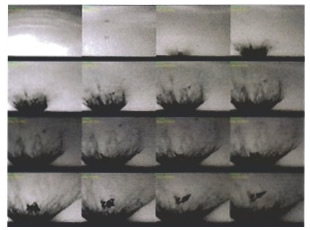Hypervelocity impact testing carried out on simulated lunar materials
The Institute of Astronautics, Technical University of Munich, Germany has used a SIM-X ultra-high speed framing camera to record high resolution images of hypervelocity impacts on granular media samples with different bulk densities.
At the Institute of Astronautics, research to investigate principles for lunar in-situ resource utilisation (ISRU) has been conducted. Lunar regolith provides a multitude of elements which are bound in ores and minerals. The thermal, chemical and mechanical properties however may change significantly upon the high pressures of a hypervelocity impact.
To simulate this process, impact tests were carried out using 25mg polyethylene or 73mg aluminium cylinders fired at 1-4Km/sec at lunar granular material simulant (JSC-1A) under vacuum conditions. Through undertaking these experiments the researchers sought to measure the velocity and angle of materials ejected as a result of hypervelocity impact to see if the ejecta might be lost from the lunar surface into space.
The main diagnostic tool used for the impact experiments was a Specialised Imaging SIM-X ultra-high speed framing camera. The camera features up to 16 discrete intensified optical channels with an image size of 1,360x1,024 pixels at 12-bit resolution.
Each frame can be programmed individually concerning gain and exposure to optimise data capture. With a minimum interframe tome of just 5ns the SIM-X can capture high quality images to help unlock the secrets of even the most fleeting pof events. The illumination of the simulated lunar surface impact event was realised using two high power flash heads with a total light duration of about 4ms.
Dr. Rott, a Researcher at the Institute of Astronautics commented: “The SIM-X camera has proven to be a powerful diagnostic tool enabling us to gain much insight into the formation and development of ejecta clouds resulting from hypervelocity impacts on simulated lunar materials.”
Rott continued: “The good time resolution of the camera recordings revealed previously unknown facts for instance that under some conditions the SWIP can rebound from the surface with a substantial velocity”. He added, “we would like to thank Mr Berkenberg, Mr Chan and Mr Bowley from Specialised Imaging for their valuable help in setting up the camera”.










